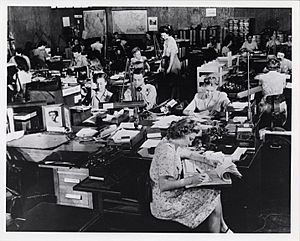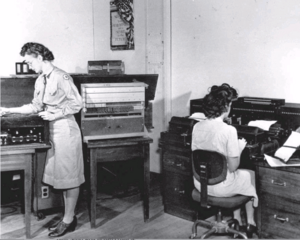Code Girls facts for kids
 |
|
| Dissolved | Yes |
|---|---|
| Type | Governmental |
| Purpose | Code breaking |
|
Formerly called
|
World War II Code Girls |
The Code Girls were a special group of over 10,000 women. They worked as code makers and code breakers for the U.S. Military during World War II. Their secret work was very important to winning the war.
Joining the Secret Mission
Before the Japanese attack on Pearl Harbor, the United States Navy started looking for women college students. They wanted them to work with secret codes. After the attack, the U.S. joined the Allied Forces. This made the need for code breakers even bigger.
When recruiting, women were asked two main questions. Did they like crossword puzzles? Were they engaged to be married? If they said 'yes' to puzzles and 'no' to marriage, they moved forward. Candidates were then invited to secret meetings. There, they learned about a special code-breaking course. They also had to promise to keep their work a secret. Those who passed the course were invited to Washington, D.C. after college. They would join the Navy as civilian workers.
The Army also began looking for women code breakers. Army leaders met with colleges for women. They wanted to find the best students before the Navy did.
Their Secret Work: Breaking Enemy Codes
The first Navy recruits worked at their headquarters in Washington, D.C. It quickly became very crowded. By 1943, the Navy took over the Mount Vernon College for Women. This became the Naval Communications Annex.
The Army's office in Washington, D.C. also grew too small. They added a second location at Arlington Hall Junior College for Women. By 1945, most of the Army's code-breaking team was female. About 70 percent of them were women.
The Code Girls had many important jobs. They operated special code-breaking machines. They also studied and broke enemy codes. They built large collections of information about enemy plans. Sometimes, they intercepted radio signals. They even tested how safe American codes were.
In 1944, the code breakers intercepted about 30,000 Japanese Navy messages each month. This helped the U.S. sink almost all Japanese supply ships. These ships were heading to the Philippines or South Pacific. Before D-Day, they sent out false information and radio messages. This tricked the Germans about where the Allied Forces would land.
If anyone asked about their secret work, the women had a cover story. They were told to say they 'sharpened pencils and emptied wastebaskets'. No one ever questioned their story.
Famous Women Code Breakers
Many amazing women helped the U.S. with code work during World War II. Here are a few of them:
- Virginia Dare Aderholdt – She helped decode the message where Japan agreed to surrender.
- Ann Z. Caracristi – She later became a high-ranking leader at the National Security Agency.
- Margaret Crosby – She worked as a code maker for a special U.S. spy group.
- Agnes Meyer Driscoll – She broke a Japanese code machine called the M-1.
- Genevieve Grotjan Feinstein – She found a key way to break the Japanese Purple cipher.
- Elizebeth Smith Friedman – She helped catch criminals during Prohibition. She also stopped Nazi spies in South America during the war.
- Helen Nibouar – She helped create a special U.S. code machine called SIGABA.


